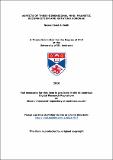Aspects of three-dimensional MHD : magnetic reconnection and rotating coronae
Abstract
Solutions of the magnetohydrodynamic (MHD) equations are very important for modelling laboratory, space and astrophysical plasmas, for example the solar and stellar coronae, as well as for modelling many of the dynamic processes that occur in these different plasma environments such as the fundamental process of magnetic reconnection. Our previous understanding of the behavior of plasmas and their associated dynamic processes has been developed through two-dimensional (2D) models. However, a more realistic model should be three-dimensional (3D), but finding 3D solutions of the MHD equations is, in general, a formidable task. Only very few analytical solutions are known and even calculating solutions with numerical methods is usually far from easy.
In this thesis, 3D solutions which model magnetic reconnection and rigidly rotating magnetized coronae are presented. For magnetic reconnection, a 3D stationary MHD model is used. However, the complexity of the problem meant that so far no generic analytic solutions for reconnection in 3D exist and most work consists of numerical simulations. This has so far hampered progress in our understanding of magnetic reconnection. The model used here allows for analytic solutions at least up to a certain order of approximation and therefore gives some better insight in the significant differences between 2D and 3D reconnection. Three-dimensional numerical solutions are also obtained for this model.
Rigidly rotating magnetized coronae, on the other hand, are modeled using a set of magnetohydrostatic (MHS) equations. A general theoretical framework for calculating 3D MHS solutions outside massive rigidly rotating central bodies is presented. Under certain assumptions, the MHS equations are reduced to a single linear partial differential equation referred to as the fundamental equation of the theory. As a first step, an illustrative case of a massive rigidly rotating magnetized cylinder is considered, which somehow allows for analytic solutions in a certain domain of validity. In general, the fundamental equation of the theory can only be solved numerically and hence numerical example solutions are presented. The theory is then extended to include a more realistic case of massive rigidly rotating spherical bodies. The resulting fundamental equation of the theory in this case is too complicated to allow for analytic solutions and hence only numerical solutions are obtained using similar numerical methods to the ones used in the cylindrical case.
Type
Thesis, PhD Doctor of Philosophy
Collections
Description of related resources
Al-Salti, N. and Hornig, G. (2009). Phys. Plasmas, 16:2101.N. Al-Salti, T. Neukirch, R. Ryan. A&A 514 (2010) A38.
Items in the St Andrews Research Repository are protected by copyright, with all rights reserved, unless otherwise indicated.

